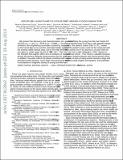KEPLER-63b: A GIANT PLANET IN A POLAR ORBIT AROUND A YOUNG SUN-LIKE STAR
Author(s)
Marcy, Geoffrey W.; Howard, Andrew W.; Isaacson, Howard; Johnson, John Asher; Torres, Guillermo; Albrecht, Simon H.; Campante, T. L.; Chaplin, William J.; Davies, Guy R.; Lund, Mikkel N.; Carter, Joshua Adam; Dawson, Rebekah I.; Buchhave, Lars A.; Everett, Mark E.; Fischer, Debra A.; Geary, John C.; Gilliland, Ronald L.; Horch, Elliott P.; Howell, Steve B.; Latham, David W.; Sanchis Ojeda, Roberto; Winn, Joshua Nathan; ... Show more Show less
DownloadWinn_Kepler-63b.pdf (2.981Mb)
OPEN_ACCESS_POLICY
Open Access Policy
Creative Commons Attribution-Noncommercial-Share Alike
Terms of use
Metadata
Show full item recordAbstract
We present the discovery and characterization of a giant planet orbiting the young Sun-like star Kepler-63 (KOI-63, m [subscript Kp] = 11.6, T [subscript eff] = 5576 K, M [star] = 0.98 M [subscript ☉]). The planet transits every 9.43 days, with apparent depth variations and brightening anomalies caused by large starspots. The planet's radius is 6.1 ± 0.2 R [subscript ⊕], based on the transit light curve and the estimated stellar parameters. The planet's mass could not be measured with the existing radial-velocity data, due to the high level of stellar activity, but if we assume a circular orbit, then we can place a rough upper bound of 120 M [subscript ⊕] (3σ). The host star has a high obliquity (ψ = 104°), based on the Rossiter-McLaughlin effect and an analysis of starspot-crossing events. This result is valuable because almost all previous obliquity measurements are for stars with more massive planets and shorter-period orbits. In addition, the polar orbit of the planet combined with an analysis of spot-crossing events reveals a large and persistent polar starspot. Such spots have previously been inferred using Doppler tomography, and predicted in simulations of magnetic activity of young Sun-like stars.
Date issued
2013-09Department
Massachusetts Institute of Technology. Department of Physics; MIT Kavli Institute for Astrophysics and Space ResearchJournal
The Astrophysical Journal
Publisher
IOP Publishing
Citation
Sanchis-Ojeda, Roberto, Joshua N. Winn, Geoffrey W. Marcy, Andrew W. Howard, Howard Isaacson, John Asher Johnson, Guillermo Torres, et al. “KEPLER-63b: A GIANT PLANET IN A POLAR ORBIT AROUND A YOUNG SUN-LIKE STAR.” The Astrophysical Journal 775, no. 1 (September 4, 2013): 54.
Version: Author's final manuscript
ISSN
0004-637X
1538-4357